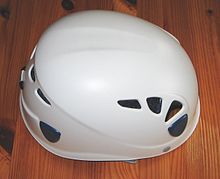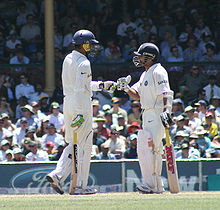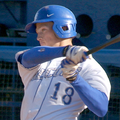- Helmet
-
A helmet is a form of protective gear worn on the head to protect it from injuries.
Ceremonial or symbolic helmets (e.g., English policeman's helmet) without protective function are sometimes used. The oldest known use of helmets was by Assyrian soldiers in 900BC, who wore thick leather or bronze helmets to protect the head from blunt object and sword blows and arrow strikes in combat. Soldiers still wear helmets, now often made from lightweight plastic materials.
In civilian life, helmets are used for recreational activities and sports (e.g., jockeys in horse racing, American football, ice hockey, cricket, baseball, and rock climbing); dangerous work activities (e.g., construction, mining, riot police); and transportation (e.g., Motorcycle helmets and bicycle helmets). Since the 1990s, most helmets are made from resin or plastic, which may be reinforced with fibers such as aramids.
Contents
Design
All helmets attempt to protect the user's head by absorbing mechanical energy and protecting against penetration. Their structure and protective capacity are altered in high-energy impacts. Beside their energy-absorption capability, their volume and weight are also important issues, since higher volume and weight increase the injury risk for the user's head and neck. Anatomical helmets adapted to the inner head structure were invented by neurosurgeons at the end of the 20th century.
Helmets used for different purposes have different designs. For example, a bicycle helmet must protect against blunt impact forces from the wearer's head striking the road. A helmet designed for rock climbing must protect against heavy impact, and against objects such as small rocks and climbing equipment falling from above. Practical concerns also dictate helmet design: a bicycling helmet should be aerodynamic in shape and well ventilated, while a rock climbing helmet must be lightweight and small so that it does not interfere with climbing.
Some helmets have other protective elements attached to them, such as a face visors or goggles or a face cage, and ear plugs and other forms of protective headgear, and a communications system. Sports helmets may have an integrated metal face protector (face cage).
- Baseball batting helmets have an expanded protection over the ear, which protects the jaw from injury.
- Motorcycle helmets often have flip-down face screens for rain and wind protection, and they may also have projecting visors to protect the eyes from glare.
- Hard hats for construction workers are worn mainly to protect the wearer from falling objects such as tools.
- Helmets for riot police often have flip-down clear visors and thick padding to protect the back of the neck.
- Modern firefighter's helmets protect the face and back of the head against impact, fires and electricity, and can include masks, communication systems, and other accessories.
- Welding helmets protect the eyes and face and neck from flash burn, ultraviolet light, sparks and heat. They have a small window, called a lens shade, through which the welder looks at the weld; for arc welding this window must be much darker than in blowtorch goggles and sunglasses.
- People with some medical conditions must wear a helmet to protect the brain, due to a gap in the braincase, e.g. because of cleidocranial dysostosis or in separated craniopagus twins.
- Mixed martial arts helmets have ear pads to prevent serious injuries to the athletes, who do not usually endure such force to the ears.
Materials
Types of synthetic fiber used to make some helmets:
In former times lightweight non-metallic protective materials and strong transparent materials for visors were not available. In Greece in ancient times helmets were sometimes strengthened by covering the surface with boars' tusks (= their canine teeth) laid flat[citation needed].
In Britain in the 18th and 19th centuries gamekeepers, for head protection in fights against poachers, sometimes wore helmets (perhaps more describable as thick bump caps) made of straw bound together with cut bramble.[1]
Types of helmet
Military
See Combat helmet for a list of helmets worn in (ancient and modern) battle combat
- Fighter pilot helmet
- PH helmet—actually a flexible hood: early types of British gas masks
- Leather helmet—aviator and tank operator headgear
Motorcycle and bicycle helmets
- Motorcycle helmet—protective helmet for motorcycle riders
- Bicycle helmet—protective helmet for bicycle riders
Sports
- Cricket helmet—protective headgear worn by batsmen in a game of cricket
- A helmet is also worn by a wicket keeper and some fielders close to the batsman.
- Equestrian helmet—protective headgear worn by horse riders
- Batting helmet—protective headgear worn by batters in a game of baseball or softball
- catcher's full face helmet
- Bull riding helmet
- Football helmet—for American football and Canadian football
- Eyeshield—a type of visor for a football helmet
- Hockey helmet
- Goalie mask
- Lacrosse helmet
- Pith helmet (a.k.a. sun helmet)
- Ski helmet—protective helmet for skiers
- Association football headgear—protective headgear worn by some association football (soccer) players
- A helmet is worn in bobsledding
- A helmet is worn in the Gaelic sport of hurling
- A helmet may be worn whilst wakeboarding. These helmets must be waterproof and may come with ear protectors to reduce the chance of a burst ear drum after a bad fall
- Safety helmet for scuba diving. Not air-holding. May have a built-in forehead light. Images at [1].
- Helmets are routinely worn in most forms of auto racing in both driver and pit crew forms.
Work
- Diving helmet—worn by professional divers engaged in surface supplied diving
- Hard hat—often seen on building sites; may have a visor
- Miner's helmet
- Space helmet
- Welding helmet—worn by welders
Protective and emergency services
- Custodian helmet—symbolic British police headgear
- Firefighter's helmet
- F1 helmet—French type firefighter helmet
- Merryweather helmets—Victorian-era fire helmet in Britain and Hong Kong
- Lifeboatman's helmet. The lifeboatman's helmet depicted below (seen at Southport lifeboat station in England on 7 September 2008) covers the same area as a motorcycle helmet including all of the ears, Its casing is thinner, and nearer to the size of the head, and has lengthwise ridges. It has a transparent visor to keep sea spray out of the eyes. It has a chinstrap. Its lining is not padded but inflatable; it has an inflation tube ending at the red nipple (at the bottom of the image), to inflate the lining by mouth to fit it firmly on the head. It has a microphone and an intercom lead.
- Riotsquad helmet
- SWAT team helmet—mostly PASGT type
Other helmets
- Pith helmet—sun protection helmet
- Mahiole—Hawaiian feathered helmet
- Winged helmet—fictional Scandinavian helmet
- Balaclava helmet—not really a helmet, a woollen face covering against cold, sometimes used for concealment
- Tarnhelm, mythical helmet that makes its wearer invisible
- Protective helmets for mentally disabled persons.[2]
Heraldry
As the coat of arms was originally designed to distinguish combatants on the battlefield or in a tournament, even while covered in armour, it is not surprising that heraldic elements were often also used for the decoration of knightly helmets, while it was also possible to use different elements than on the shield, but equally standardized.
Furthermore, it became common to use a helmet (or some other headgear, e.g. a crown or coronet) as part of the coat of arms, above the shield, a practice maintained long after helmets themselves ceased to be used. In some systems, the rank of the bearer was reflected in the model of the emblematic helmet, e.g. the metal and the number of bars in the visor, as in France. The rank can be denoted by a coronet or wreath placed on the helmet (often instead of directly above the shield).
The heraldic convention in the United Kingdom is as follows:
- Sovereign: a barred helm of gold, placed affronté
- Peers generally: barred helms of silver decorated with gold, placed sideways and showing five bars
- Baronet's or Knight's helmet:
- Esquire's and Gentleman's helmet: closed helm or visored helm with visor down, Steel, placed sideways
Gallery
-
Jousting helm c. 1498, study by Albrecht Dürer
-
Vietnam War Era Marine Squadron VMA-311 Flight Helmet
-
Lifeboatman's helmet, Southport, England.
-
Helmet for nurse going into chemical-hazard situation, Wythenshawe Hospital, 26 September 2010
-
Safety helmet for medical personnel, Wythenshawe Hospital, 26 September 2010. The visor goes between two layers of the helmet.
See also
References
- ^ The Long Affray, by Harry Hopkins, publ. 1985 Secker & Warburg, London, ISBN 0-436-20102-X
- ^ http://www.google.com/patents/about?id=0-wuAAAAEBAJ&dq=4317239
External links
 Media related to Helmets at Wikimedia Commons
Media related to Helmets at Wikimedia Commons- "Helmets...A Medieval Note In Modern Warfare", August 1942, Popular Science evolution of military helmets
Wikimedia Foundation. 2010.


















